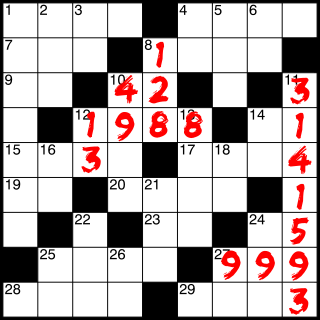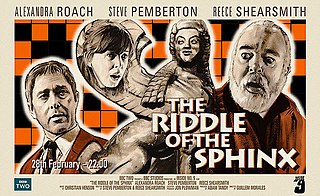
Self-reference is a concept that involves referring to oneself or one's own attributes, characteristics, or actions. It can occur in language, logic, mathematics, philosophy, and other fields.
Word games are spoken, board, or video games often designed to test ability with language or to explore its properties.

A crossword is a word puzzle that usually takes the form of a square or a rectangular grid of white- and black-shaded squares. The goal is to fill the white squares with letters, forming words or phrases that cross each other, by solving clues which lead to the answers. In languages that are written left-to-right, the answer words and phrases are placed in the grid from left to right ("across") and from top to bottom ("down"). The shaded squares are used to separate the words or phrases.
A cryptic crossword is a crossword puzzle in which each clue is a word puzzle. Cryptic crosswords are particularly popular in the United Kingdom, where they originated, Ireland, Israel, the Netherlands, and in several Commonwealth nations, including Australia, Canada, India, Kenya, Malta, New Zealand, and South Africa. Compilers of cryptic crosswords are commonly called "setters" in the UK and "constructors" in the US. Particularly in the UK, a distinction may be made between cryptics and "quick" crosswords, and sometimes two sets of clues are given for a single puzzle grid.

Nonograms, also known as Hanjie, Paint by Numbers, Picross, Griddlers, and Pic-a-Pix, and by various other names, are picture logic puzzles in which cells in a grid must be colored or left blank according to numbers at the side of the grid to reveal a hidden pixel art-like picture. In this puzzle type, the numbers are a form of discrete tomography that measures how many unbroken lines of filled-in squares there are in any given row or column. For example, a clue of "4 8 3" would mean there are sets of four, eight, and three filled squares, in that order, with at least one blank square between successive sets.
The National Puzzlers' League (NPL) is a nonprofit organization focused on puzzling, primarily in the realm of word play and word games. Founded in 1883, it is the oldest puzzlers' organization in the world. It originally hosted semiannual conventions in February and September of each year, but conventions are now held annually, in July.

William F. Shortz is an American puzzle creator and editor who is the crossword puzzle editor for The New York Times. He graduated from Indiana University with a degree in the invented field of "enigmatology". After starting his career at Penny Press and Games magazine, he was hired by The New York Times in 1993. Shortz's American Crossword Puzzle Tournament is the country's oldest and largest crossword tournament.

Kakuro or Kakkuro or Kakoro is a kind of logic puzzle that is often referred to as a mathematical transliteration of the crossword. Kakuro puzzles are regular features in many math-and-logic puzzle publications across the world. In 1966, Canadian Jacob E. Funk, an employee of Dell Magazines, came up with the original English name Cross Sums and other names such as Cross Addition have also been used, but the Japanese name Kakuro, abbreviation of Japanese kasan kurosu, seems to have gained general acceptance and the puzzles appear to be titled this way now in most publications. The popularity of Kakuro in Japan is immense, second only to Sudoku among Nikoli's famed logic-puzzle offerings.

The American Crossword Puzzle Tournament is a crossword-solving tournament held annually in February, March, or April. Due to the COVID-19 pandemic, the 2020 tournament was canceled. In April 2021, the 43rd tournament was held virtually. Founded in 1978 by Will Shortz, who still directs the tournament, it is the oldest and largest crossword tournament held in the United States; the 2019 event set an attendance record with 741 competitors, including over 200 rookies.
Games World of Puzzles is an American games and puzzle magazine. Originally the merger of two other puzzle magazines spun off from its parent publication Games magazine in the early 1990s, Games World of Puzzles was reunited with Games in October 2014.
A metapuzzle, also known as a meta-puzzle or meta, is a puzzle that uses the solutions to a set of puzzles to create or provide data for a final puzzle.

An acrostic is a type of word puzzle, related somewhat to crossword puzzles, that uses an acrostic form. It typically consists of two parts. The first part is a set of lettered clues, each of which has numbered blanks representing the letters of the answer. The second part is a long series of numbered blanks and spaces, representing a quotation or other text, into which the answers for the clues fit. In some forms of the puzzle, the first letters of each correct clue answer, read in order from clue A on down the list, will spell out the author of the quote and the title of the work it is taken from; this can be used as an additional solving aid.

Bend Studio is an American video game developer based in Bend, Oregon. Founded in 1992, the studio is best known for developing Bubsy 3D, the Syphon Filter series, and Days Gone. Since 2000, Bend Studio is a first-party developer for PlayStation Studios.
Timothy Eric Parker is an American puzzle editor, games creator, author, and TV producer.
The New York Times crossword puzzle is a daily American-style crossword puzzle published in The New York Times, online on the newspaper's website, syndicated to more than 300 other newspapers and journals, and on mobile apps.

A cross-figure is a puzzle similar to a crossword in structure, but with entries that consist of numbers rather than words, where individual digits are entered in the blank cells. Clues may be mathematical, use general knowledge or refer to other clues.

Merv Griffin's Crosswords is an American game show based on crossword puzzles. The show was created by its namesake, Merv Griffin, who died shortly after beginning production on the series. Ty Treadway was the host, and Edd Hall was the announcer.
Elizabeth S. Kingsley was an American puzzle constructor, famous as the inventor of the double-crostic.

A Printer's Devilry is a form of cryptic crossword puzzle, first invented by Afrit in 1937. A Printer's Devilry puzzle does not follow the standard Ximenean rules of crossword setting, since the clues do not define the answers. Instead, each clue consists of a sentence from which a string of letters has been removed and, where necessary, the punctuation and word breaks in the clue rearranged to form a new more-or-less grammatical sentence. The challenge to the solver is to find the missing letters, which will spell out a word or phrase that should be entered into the grid.

"The Riddle of the Sphinx" is the third episode of the third series of the British dark comedy anthology television programme Inside No. 9. It first aired, on BBC Two, on 28 February 2017. The episode was written by the programme's creators, Steve Pemberton and Reece Shearsmith, and directed by Guillem Morales. "The Riddle of the Sphinx", which is set in Cambridge, stars Alexandra Roach as Nina, a young woman seeking answers to the Varsity cryptic crossword, Pemberton as Professor Nigel Squires, who pseudonymously sets the crossword using the name Sphinx, and Shearsmith as Dr Jacob Tyler, another Cambridge academic. The story begins with Nina surreptitiously entering Squires's rooms on a stormy night and being discovered; this leads to Squires teaching her how to decipher clues in cryptic crosswords.












